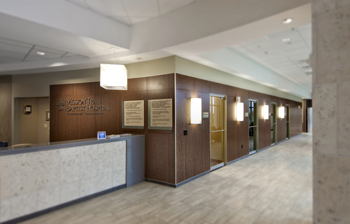San Antonio Hospital Builds Natural, Gets LEED
 SAN ANTONIO — The 110-bed Mission Trail Baptist Hospital achieved LEED Gold certification last month, and it is the first acute-care hospital in the state to do so, as well as the first LEED-certified hospital in San Antonio. The facility was built as a replacement hospital for Southeast Baptist Hospital, and construction was completed in June 2011.
SAN ANTONIO — The 110-bed Mission Trail Baptist Hospital achieved LEED Gold certification last month, and it is the first acute-care hospital in the state to do so, as well as the first LEED-certified hospital in San Antonio. The facility was built as a replacement hospital for Southeast Baptist Hospital, and construction was completed in June 2011.
Architects and designers from Nashville, Tenn.-based Earl Swensson Associates Inc. used the LEED requirements to drive the design of the 220,000-square-foot facility, which is part of Baptist Health System, a wholly owned subsidiary of Vanguard Health Systems, located in Nashville.
“As part of the decision to create a new facility [instead of refurbish it], Vanguard was very interested in creating operational efficiencies for the long term. A lot of LEED requirements drive down operational costs over time. The company also has a philosophy around sustainability, and they wanted to do everything they could to be as green and sustainable as they could,” said Landon Lawson, chief development officer for Resolute Health, owned by Vanguard Health Systems. “That’s what drove the design and determined what made sense. We looked at the project from a sustainability perspective and then assessed what’s going to happen from an operational point of view.”
The design team knew that LEED certification was a requirement, but it wasn’t until the construction process evolved that they realized the project could achieve Gold. “We started assessing where we were when we got to the end, and only a handful of things left were required of us to achieve LEED Gold,” Lawson said.
For example, charging stations for electric cars in the parking lot were one of the requirements that Lawson said was a “quick pick up but had a real benefit.” Other sustainable elements included the use of natural light, an irrigation system that uses graywater and high-efficiency indoor plumbing and the installation of a 10 kw solar array that helps save on electrical costs.
The building materials were also harvested and manufactured within 500 miles of the build site, 34 percent of which were San Antonio made. Also, 21 percent of the materials used have high-recycled content. All of the sustainable elements give the facility the potential to save up to $150,000 in energy costs and 1.1 million gallons of potable water per year.
Sustainability efforts aside, the team also wanted to create an environment that was both light and quiet for the patient. “You can’t underestimate the importance of the therapeutic effects from Evidence Based Design. Natural light and design have such an impact on patient healing and really do make a difference in people’s lives,” Lawson said.
Natural light was incorporated into the design by using lots of windows and vaulted ceilings, as well as translucent materials. The team also used natural-looking surface materials such as Wilsonart High Pressure Laminate in the interior because it is made of recycled content and can last longer than real wood or veneer plywood.
A lot of local accents, such as the mosaic tile outlay of the San Antonio River located in the meditation garden, were also highlights of the design. The art piece was created by a local artist and depicts each of the city’s missions along the river, explaining where the hospital sits within the area. A rock wall along the stairwell was made out of patterned porcelain tile called “horn” and some of the local Texas limestone.
The hospital has been open for more than a year and a half, and despite only having 10 days to move equipment from the old hospital to the new location about four miles away, the facility opened successfully. It saw 86 patients in the emergency department on the first day it opened, and within two weeks, it was fully occupied, said Lawson.
